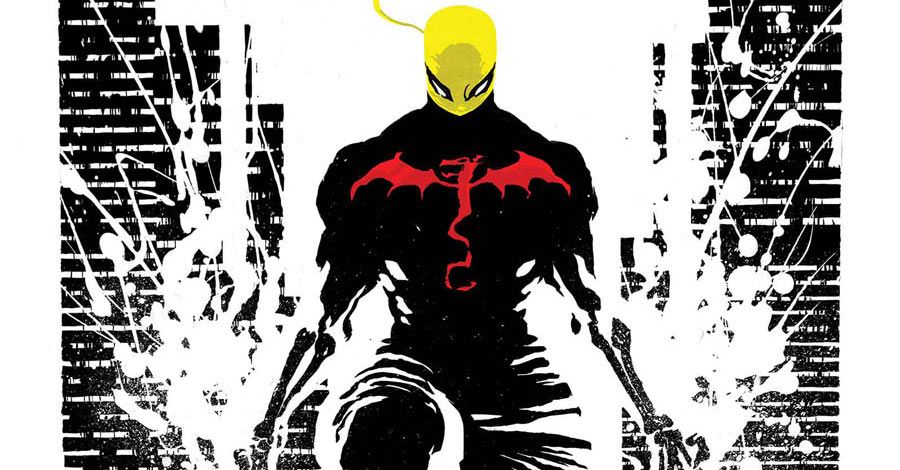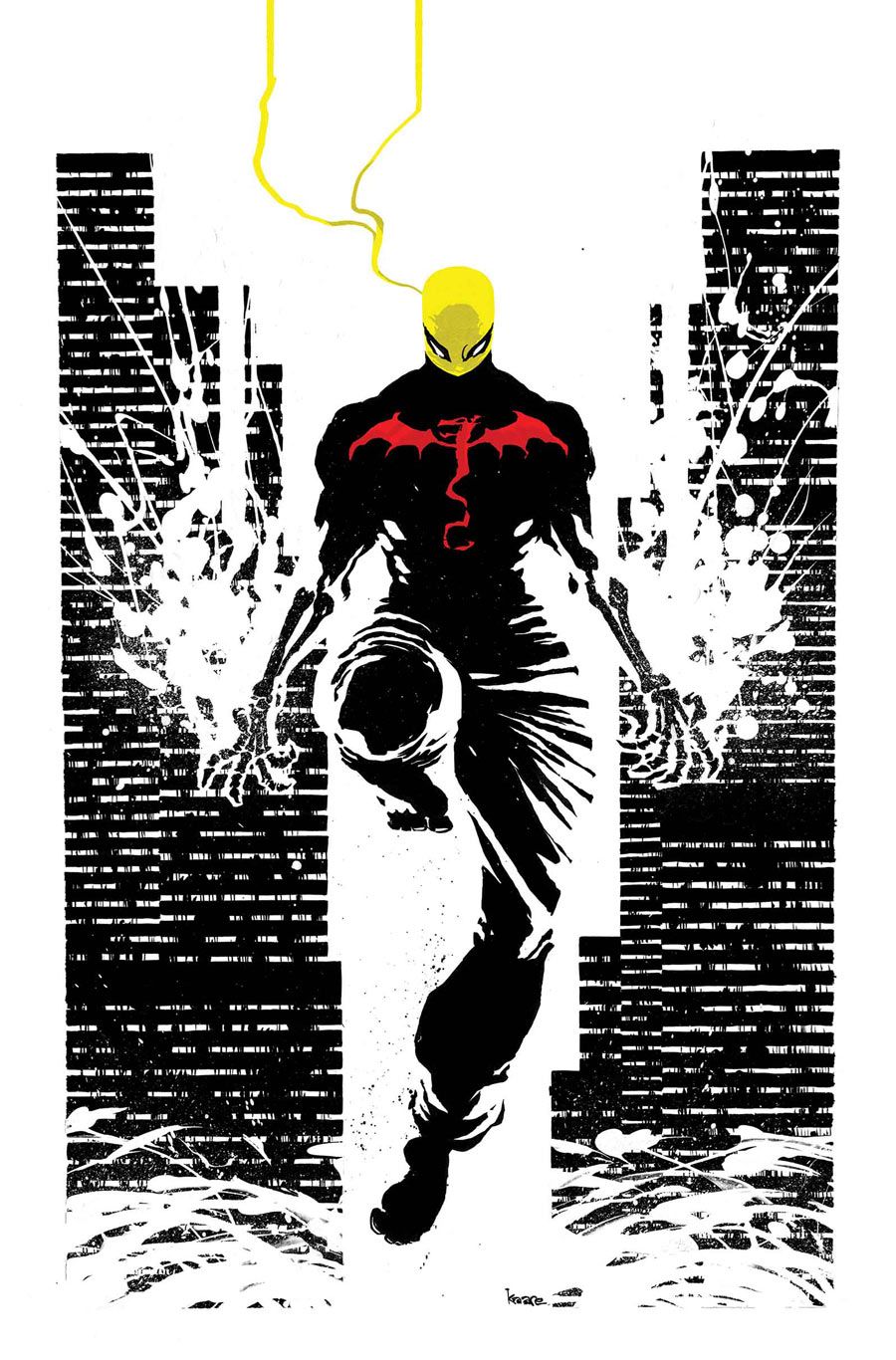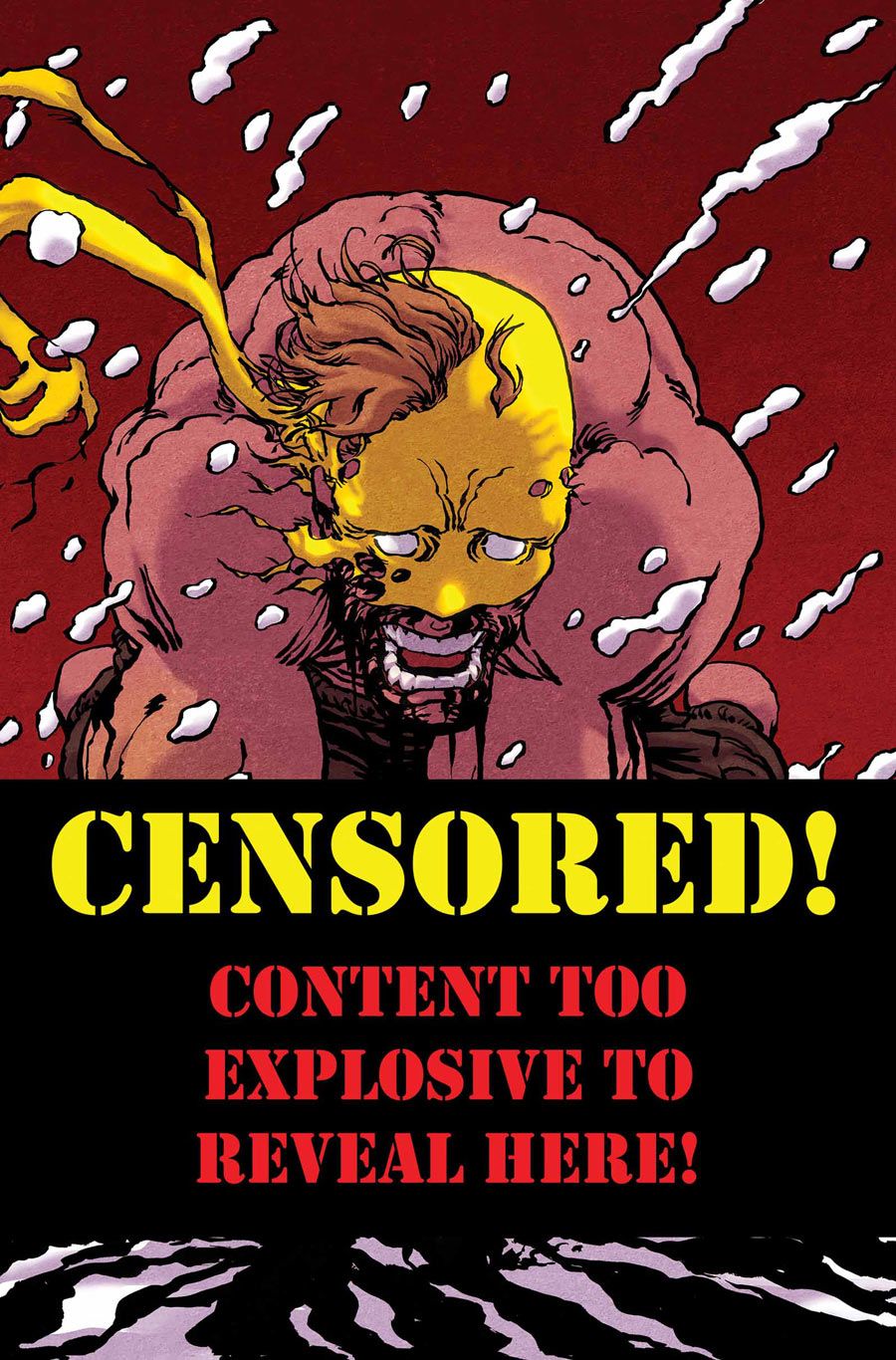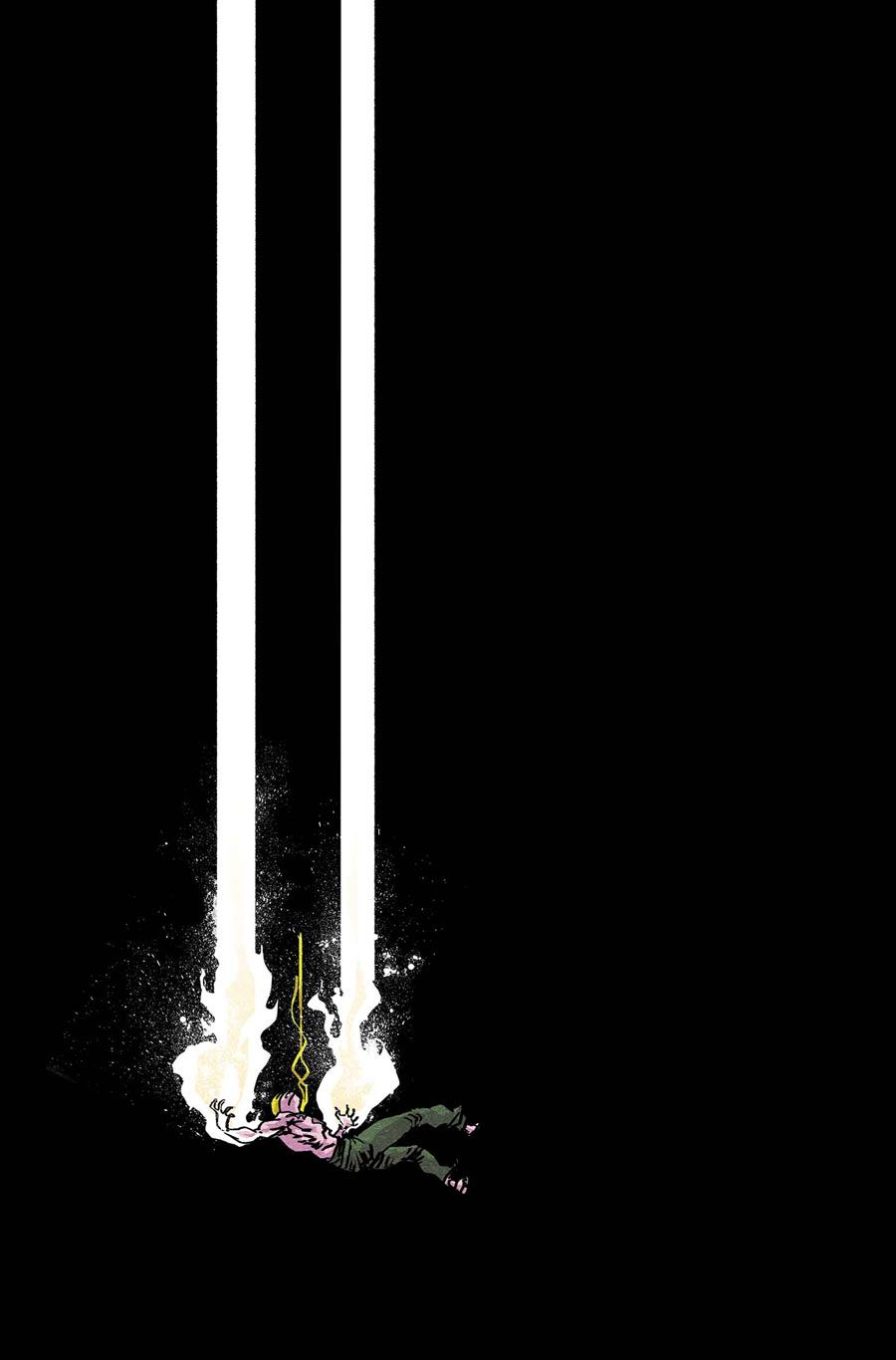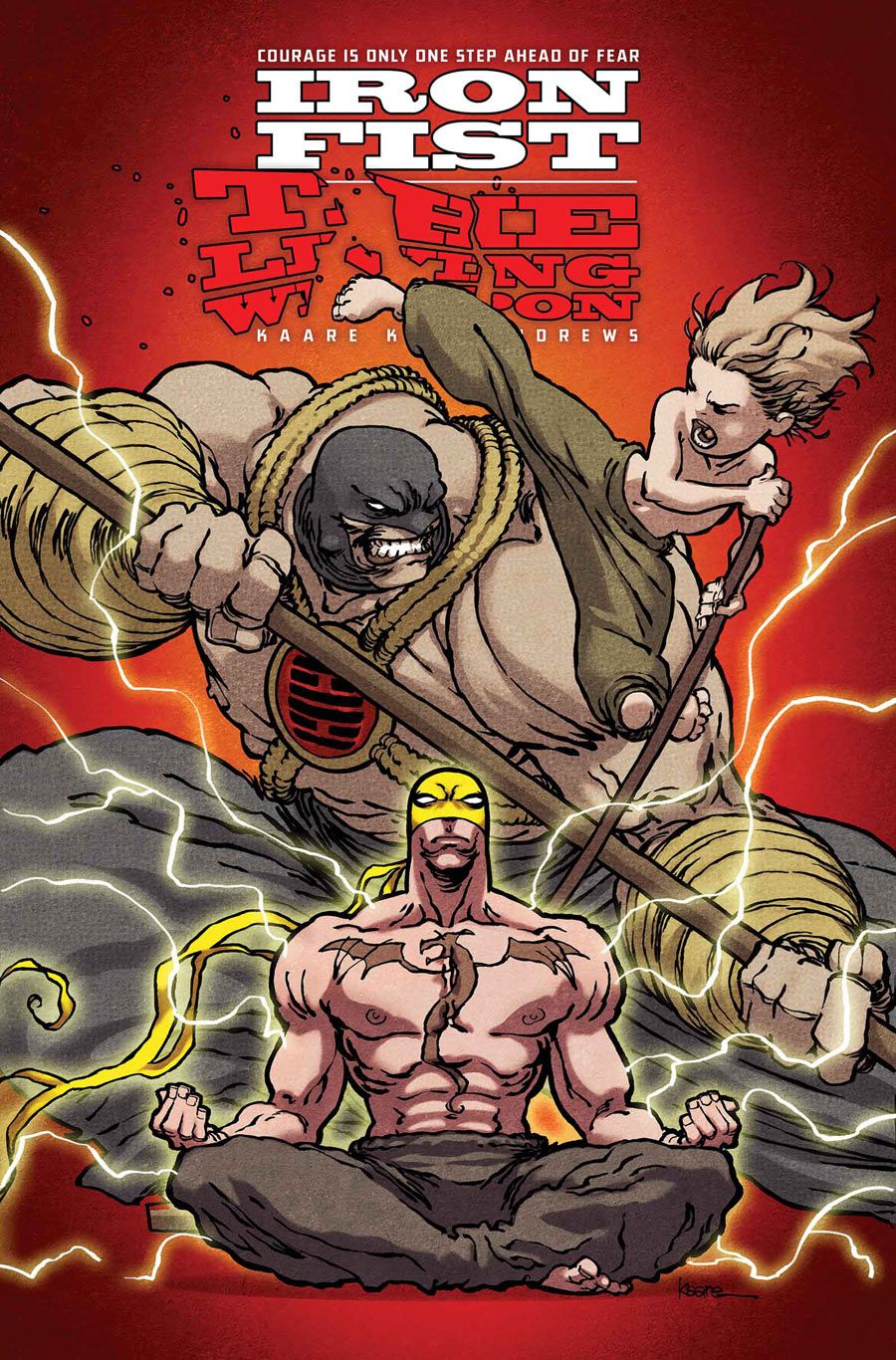Danny Rand has tried to make the most of his life as the costumed super hero known as Iron Fist in the Marvel Universe. He's built friendships with heroes like Luke Cage, joined super teams like the Avengers and the Defenders, served as a mentor to younger heroes like the new Power Man and has even given back to the community in the form of the martial arts school he founded for underprivileged youth. Has all the good he's done been Rand's way of avoiding the traumatic past that transformed him into Iron Fist in the first place?
In Marvel's ongoing "Iron Fist: The Living Weapon", writer/artist Kaare Andrews has let the ghost of Danny Rand's past come back to haunt him in a major way. CBR News spoke with Andrews about the series, Danny's past and if the hero will ever be able to truly move forward in spite of it.
CBR News: Kaare, in the back pages of "Iron Fist: The Living Weapon" #1 you talked about how some of your plans for Iron Fist may feel off, and some may be flat out wrong. I'll admit to feeling some of that myself, but after reading the flashback sequences in issue #3 where Danny trains with Lei Kung, the Thunderer, something clicked for me. Is the reason Danny feels off because he hasn't fully dealt with the emotional trauma he endured as a child and that's manifesting as these dark moods we've seen him in?
Kaare Andrews: That's exactly correct. One question you face when you do comic books is you ask yourself, "Who is this character?" Then the second part of that questions is "What is continuity?"
The two answers to those questions are: one, Iron Fist doesn't quite have the core of a character that, say, a Spider-Man, Superman, or Batman does. He is not so easy to sum up into a single sentence like "with great power comes great responsibility" or "an orphan of murdered parents vows to fight crime" or "the alien living amongst us showing us what it means to be human."
I think that's what's been holding Iron Fist back this whole time as a character. He's really cool. He does cool things. He looks amazing. He's been around forever and he has a loyal fan base, but I don't think a larger audience has been able to connect with him because I don't think he's had a clear core in a long time.
RELATED: Kaare Andrews Trains for "Iron Fist: The Living Weapon"
Then if you look at the other question of "what is continuity" -- the other problem I had with Iron Fist initially was that when you look at his debut in "Marvel Premiere" #15 it is very clear to me what his core is. He's a boy who saw his parents murdered and instead of declaring war on crime he spent 10 years training to have his vengeance only to discover it to be an empty pursuit.

Then if you look at the continuity of the character over the past few years you wonder what has he become? He's kind of become this Spider-Man type guy. He's a rich Caucasian male in one of the most prosperous cities in the world, though. He's in one of the most privileged positions I could ever imagine, and he's a super hero. What has he done with that position? Helped some kids learn Kung Fu.

That doesn't seem right. There are some things that this character is not dealing with. He preaches an enlightened life, but he has not become an enlightened person. So for me there were some interesting ideas that I immediately drew on and was fueled by. If you go through that much damage as a young child -- watching your father thrown off a cliff by his best friend; watching his best friend try to seduce your mother moments later; and then moments after that your mother is eaten by wolves in front of your eyes; and then you're taken in by crazy mystical monks to train 10 years so you can kill the guy who murdered your father -- that doesn't go away.

If you speak to anyone who's experienced emotional trauma as a child, whether it's something as serious as sexual abuse or something as simple as being shamed in front of a classroom of other kids, you know that stuff doesn't go away. The whole idea of talk therapy is you deal with that stuff by talking about it and dealing with it. You become a better person because you acknowledge it. If you acknowledge your flaws and where you've come from that's how you can move on, but I haven't seen Danny Rand deal with or acknowledge that stuff in a long time. I was instantly inspired by my background as a student of human nature and the disparity between the core of his character and recent characterizations.
So the character that I know Danny Rand to be is probably not the character that may people think he is. If you know him only from things like the "Ultimate Spider-Man" cartoon; the Chris Claremont "Iron Fist" run; If you know him from his very first Origin story by Roy Thomas, one of the darkest super hero origin stories every written; or "The Immortal Iron Fist," the light-hearted romp through a kung fu tournament, those are all very different people. So I'm going to assume that my version is not your version, because none of those other versions are alike either. And because I'm writing and drawing this myself it's a very pure process and my ideas are not going to be mitigated through the hands of other people.
It's a very direct, raw and aggressive way to do it and the worst result that could happen would be if someone were to say, "It was so amazing it felt just like 'The Immortal Fist' or if they said "It's just like the Chris Claremont run." That would be a failure for me as a creative. So all those things combined into a fair warning in issue#1 that whatever is going to be expressed in this comic is probably going to throw you off a bit. So hold on and enjoy the ride because that's what it's going to be.
You're not concerned with just Danny's early past. You're also playing with some of the mythology from "The Immortal Iron Fist" series. We saw one of the characters from that series, Orson Randall's daughter, the new Thunderer, murdered by Davos in "Living Weapon" #2. Why did you want to kill her off?
You're half right there. We did showcase that character. That's all I'll say to that, but I'll ask again, "what is continuity?" If you've only read one storyline about Iron Fist that's your idea of continuity and depending on where that fits in the timeline of 40 years of storytelling as a reader you're going to see that blue is red, red is orange, and green is yellow. For instance, Danny's father has been portrayed as both the literal blood brother of the first Yu-Ti and then later as some kind of non-related outsider. Which one is which? So for me it was a tricky proposition.
I really loved "The Immortal Iron Fist." I did a few covers during the run and I read it and enjoyed it. But I wouldn't want to be enslaved by other people's ideas, though -- especially when they are creating their own retcon retellings of history. At a certain point it doesn't matter. There's either a good story or there isn't. It's funny. I've read a couple responses on the Internet, which is always a fun place to live. I try not to read reviews, but I came across one where one reviewer wrote, "Oh my god Kaare Andrews is such an idiot! He had the wolves kill Danny's mother. Why couldn't she have done anything? Was that really the way to go?" That's from the origin story, though. That's Roy Thomas. Don't blame me. [Laughs] I'm acknowledging it happened and I want to remind you that it happened because it's so crazy and you may have forgotten, but it actually happened.

Another thing was, "Kaare Andrews wrote that there's a teleportation device in his building that takes him back to K'un-Lun. That's stupid." I didn't invent that. I'm acknowledging that it's there. It was there in the Matt Fraction-Ed Brubaker run. I'm picking and choosing which pieces I really want to adhere to continuity wise. I'm picking the ones that inspire me. Then with the rest I'm not saying anything didn't happen. I'm taking what I want and letting the rest float around out there.
It's clear from issue #3 that you brought in some of the stuff you like, like the Prince of Orphans and the Crane Mother's Daughters.
Yeah, like I said, I loved that run. There are things I want to incorporate and I am incorporating. I'm already on issue #7. So I can read the reviews and responses with a clear head. That would be more dangerous to do so if I was earlier in the run. So there's more stuff coming.
I'm really excited to see how people respond to issue #4. We've had three issues of just chaos, destruction, murder, and world burning, but in issue #4 there's a moment of reprieve. We take a deep breath before we go back into the fight. It's kind of a between rounds type of issue, and it's something I don't think has really been done before, technique-wise. So I'm curious to see how people like it.
Another interesting development in this series was Davos' shift back toward a more villainous path. When he first debuted Davos was evil, and when we last saw him he was trying to walk the path of a hero, but it looks like something has made him return to his villainous roots.
Yes, an alcoholic is always an alcoholic. He may be sober but he will never not be an alcoholic. His every day is a struggle to be sober. And there's a reason why we have the scorpion and the frog story. It's such an over used cliche because it's true. People have choices that they adhere to in life that are fundamental to their inner being; their genome. And I think with Davos it's not that he's evil it's that if we were to break him down he's probably a narcissist and a sociopath. He doesn't quite connect emotionally to the people around him. He's always going to feel overlooked and underprivileged. That fuels his drive for wanting to have power and be important. These are not choices people make, these are fundamental aspects of their natural make-up. Could Jeffrey Dahmer just decide to stop being a serial-killer?
Now he has been working on it and he was tasked to guard the dragon eggs and be a good sport, but how long can you deny your true nature before it bubbles up again? So he's a very interesting character that I haven't really had time to explore in the first three issues. I'm hoping to find some moments to crack the surface of his shell later on. He's always been so interesting to me and I love what he represents as a character and a counterpoint to Danny.
As I mentioned, in "Iron Fist" #3 the Prince of Orphans and the Crane Mother's daughters get involved. This suggests to me that whatever is going on here involves more than just K'un-Lun and its battle against the death ninjas -- that all of the Seven Cities have a stake in what's going on.
You could assume something like that. [Laughs] Let's just say we are building toward a finale of epic proportions. The first three issues are a small step toward a much bigger situation that will eventually erupt and explode between different worlds. I'm almost scared of where we're going to go. We're going to go so big and so crazy I'm not sure if we even have the page count to do the things that I want to do as a writer and as an artist. It's kind of daunting, but it's very exciting for me.
The result of that big finale is a single image that I'm working toward that I'm so excited to do as a writer and an artist. There's a final moment that I think will sum up Danny's core as a character, the journey he took, how he's changed, and how others are the counterpoint to his being, the foil of his character. So I'm excited to get to the end of this thing. It will be fun.
Let's move to the other villains of your story, the death ninjas. It feels like they're meant to be the opposite number of K'un-Lun in that K'un-Lun is all about life and they're all about death. K'un-Lun also uses sort of feudal technology while the death ninjas utilize modern day tech.
Yeah, there definitely is a polarity there. K'un-Lun is a city of immortals, and the ninjas are not normal ninjas. Like you said, they're undead ninjas fueled by technology. K'un-Lun has banned technology and I'm very interested in what that means. What does it mean when you have a city of warriors who outlaw technology? What would be the philosophical purpose of that? Is it so they can become enlightened beings? Is it a way of controlling that population? Is it a way to show that a civilization is as the end of its lineage and can't transition to the next era? And what does it mean to have an army of death and an army of technology? I love those thematic things and exploring the juice of that.

Danny is a character caught between both life and death, but he's also caught between K'un-Lun and modern Earth. He's caught between tradition and technology. He's the perfect character to be caught up in all of these different things.
You also add to the conflicting elements with issue #3's big reveal. It looks like Danny's dead father came back to life to murder his surrogate father, Lei Kung. Did the person whose death he wanted to avenge effectively destroy the new family Danny built for himself?
Yes, exactly. These are things that make me happy to create. We'll get into more of what that means, how that happened, and who this person that appears to be Danny's dead father is. Is he really who he presents himself as? This is all part of the thematic exploration of when Danny was offered life he chose death. In that first Iron Fist origin story you learn that Danny was given the opportunity to live forever in K'un-Lun, but instead he went out into the world to get revenge on the man who killed his father. These are the consequences of that decision. My favorite stories are the ones that grab on to a thematic statement firmly and explore it in every character, every plot point and image.
Let's move into some of the new supporting characters you've introduced starting with Brenda, the reporter. What inspired her character? Is she meant to be the reader's P.O.V. into this world of Iron Fist and K'un-Lun?
Really the inspiration for Brenda is my wife. She's a very smart and intelligent woman. She's a veterinarian, but she loves watching "The Real Housewives." She's a real character and I thought, "Why hasn't there been a character like this in a comic book?" Why can't there be someone that enjoys all the superficial trappings of the world in a way that's child-like and fun in the same way that you and I might enjoy comic books and conventions?

The funny thing is, if you were a male character where all you could talk about was comic books, toys and video games it would be very accepted by the comic book community. What was interesting though, because of that first issue where Brenda was just talking about cars, penthouses and those sorts of things, I got a lot of responses suggesting that I was being very misogynistic. Maybe I was? I don't know, but that's what the character wanted to be.
The character wanted to be someone who was concerned with these things, but that's only one aspect of the character. We've only really just met her. I've read some responses now from people who are really starting to enjoy the character. Hopefully everyone will fall in love with Brenda the same way I fell in love with my wife and acknowledge that someone who watches "Real Housewives" and would love to drive a fancy car can actually be a very intelligent and loving person. They just enjoy different things.

She also has an agenda of her own, which we'll get into. I'm excited to explore that. She's not quite what she presented herself to be in the first issue, which I think everyone understands. We all have a face we wear when we are getting to know someone. Eventually that mask wears away and you start to see the person underneath.
I hope anyone who thought I was being totally misogynistic and sexist by having her sleep with this guy on the first date realizes that happens in real life, and that they stick along for the ride. I think you'll find that she's a multi-layered character with a lot of dreams, goals and ambitions beyond what you've seen. That's already started to happen, so hang in there.
Moving from characters to what's left of this initial story, how many chapters are in this inaugural arc? And what hints or teases can you offer up about the remaining action in the story?
My run on this is book is a 12-issue "first season." It's split between two six-issue arcs. The first arc is called "Rage," which you may have seen happening in those pages. [Laughs] Then the second arc is called "Redemption." It's really the journey of a character pulled into hell and the journey of him coming back out of it. So the stakes only get higher as the story moves along.
I created a few new characters for this story and my favorite so far has been Pei. Why hasn't there been more super heroes out of K'un-Lun? This is a race of immortals that are trained in the deadliest forms of martial arts. There are the Immortal Weapons, but they're from other cities. Why can't we have an Iron Fist from K'un-Lun? So for me, Pei may be a person where that can happen. It's a seed that I at least want to plant that perhaps myself or another writer can grow into what would be a good version of an Asian super hero from K'un-Lun, not something that's put onto a character just because they know Kung Fu.
She also represents a kind of foil for Danny. Where Danny was a young boy who was fleeing the Western World and was taken in by this mystical Eastern culture, she's a young girl who was fleeing an eastern mythical world and finding safety and sanctuary in the modern Western World. There will be some cool things for her and she has some interesting things in her backpack. We'll see what that means and why people are after her. So I'm excited about that.
By the end of issue #12 I really think this book will have been an exhilarating roller coaster ride. My only hope is that people enjoy it.
CBR SUNDAY CONVERSATION: Kaare Andrews
Do you think you might stick with "Iron Fist: The Living Weapon" beyond this "season?" Or is it 12 issues and then you're out?
We haven't really talked about that a lot. It's designed so after 12 issues you'll have a complete, full experience. We'll call it a first season. After that? I don't know. I think we'll cross that bridge when we come to it. The funny thing is that in today's climate a 12-issue run on something is considered quite extraordinary.
That blows my mind. I grew up reading comic books when 12 issues was just a year. I am part of that climate though. I have never written and drawn anything more than a six-issue totality. My "Spider-Man: Reign" series was about six issues of story. It was released in four oversized issues and I'm already on issue #7 of "Iron Fist." I've already exceeded my -- strange enough as it sounds -- record for staying on a book. So, for me, 12 issues is a lot, but it's going by quick.

We'll see how it all plays out. Before I started page 1 of this book I laid out all 12 issues of story. I also had a place for it to go when it's over. So it would be fun to do a second season. I know what I would want to do and who would be in it. It would probably be a little more street level than K'un-Lun because I leave K'un-Lun in a hot mess. [Laughs] But again, that's to be determined.
Let's talk a little bit about your art for this series. One of the things that I've really enjoyed is the way you've designed and presented the flashbacks. I like that they have a battered, vintage comic look to them that suggests memories ravaged by time.
That's an idea that I've used once before. I did a "Wolverine Annual" with Daniel Way back in the day and that was the very first time I did that. I guess part of the reason is that I direct movies, too, and there's this language in movies where when you use your flashbacks you might color correct your film so it has a '70s-style palette or even introduce grain. You can use all these kinds of visual clues to tell the viewer without saying it that you are in another time and space.

I knew I wanted to jump time lines in this book, but I didn't want to caption things every time I did it. So I asked myself, "What is the comic book version of those visual clues we use in film?" So I did this back in that "Wolverine Annual" and it turned out pretty good, and I think I pushed it a little further this time and added in some of the elements from '80s printing techniques. The half toned dots as well as the aged paper; things like that. I don't know why anyone hasn't done that before. It seems so simple, so easy, and so effective. It's an easy solution to present a multi time line story.

Then what you'll notice is, and I don't know if I've done it yet in the first three issues, but definitely by issue #4, if I have a flashback that has happened very recently there may only be a single crease through the corner. So the older the flashback the more damage I add to the page and I will start varying the printing techniques. Then with the more recent flashbacks it might be something very subtle.
I don't know if anyone will notice, but I like that stuff. I think it's a visual exploration of some of the concepts of comic books and it's something you could only do in a comic book. I love trying to find things that you could only do in a comic book like panels that are words, or the way panels interact with each other.
There's so much language in comic books and I think a consequence of separating artist from letterer from writer is that the language isn't used to its full capacity. We started lettering comic books digitally, which is great. It's fast, clean, looks nice and allows for last minute changes to the script. But what you lose is the artist's hand in that lettering. So you lose touches of people like the Walt Simonson, the Will Eisner, and the Jim Steranko. You lose the artist doing some of that lettering.

So I wanted to make sure that I got to do that. My goal is to have fun and fully immerse myself in this medium. I took a year off to do a film and when I came back I had such a need to do a comic book. That's why I wanted to write and draw a book. I wanted to give myself every opportunity to use every tool that was available.
Like I said in that first issue, I wanted to do the Jim Steranko thing where it was words, pencils, inks, colors, everything. The great result of doing that is normally when you draw in a way to rely on the coloring you kind of set yourself up for failure because even if the colorist is great they're not in your mind. They don't know where you think your light source should be and they're probably backed up with other work because the colorist is the last person to touch a page. Even if your page hits them early they're coloring three other books and they all might be late.
So you never know what you're going to get back even from the best colorists. It's someone else's mind and someone else's time table, but when you color it yourself you can make choices. I'm coloring some pages right now and I'm even erasing my art as I color because in a comic book cross hatching is the visual representation of a shadowed area. If I'm shading with color maybe I don't need that cross hatching any more. If I do a shadowed color gradient over the top of the cross hatching it might be too many things trying to say one thing, and if I take one of those things away it might be more interesting. So for me this is a way of fully exploring that process of doing everything and some of the cool results that could happen.
Finally, it feels overall that this season of "Iron Fist: The Living Weapon" is a story that's very much about Danny and the place that shaped him, K'un-Lun, but is it also about his place in the Marvel Universe? Is there a chance that we'll see characters like Luke Cage and the Avengers pop up further down the road?
No, not at all. There will be no other characters like that in this series. There are two reasons why. One, when is the last time we truly saw Danny on his own? My idea of any kind of hero is you put him in an impossible situation, you watch him fail against that situation and then you root for him to dig himself out. If the way he digs himself out is by calling his buddies on the telephone I'm probably not going to enjoy him as a hero as much as I would if he did it himself.
So I've always been drawn to these kind of lone wolf super heroes whether it's Spider-Man or Wolverine or whoever. I love that journey of one man against everything. In this story Danny Rand is not one man against a world. He's one man against two worlds. He's coming up against his past, present, and future all at once. I love the impossible odds he's going to find himself up against.

The second thing is just in terms of martial arts. Kung Fu is not a team sport. By it's very nature it's one man against another, or one man against 100, or one against 1,000. So to stay true to the definition of a martial arts, action-adventure story I really felt that he needed to be on his own. If there's another season we could explore some of those other things, but we've already seen so much of it in the other stories. I don't feel like we're missing any of that.
I felt like what we were really missing was Danny's core. This idea of him choosing death over life and the consequences of that on a singular individual level. He literally chose death over life. And there are consequences to that kind of a decision. And it's my task as a creator to make sure he meets them.
"Iron Fist: The Living Weapon" #3 is on sale now.

